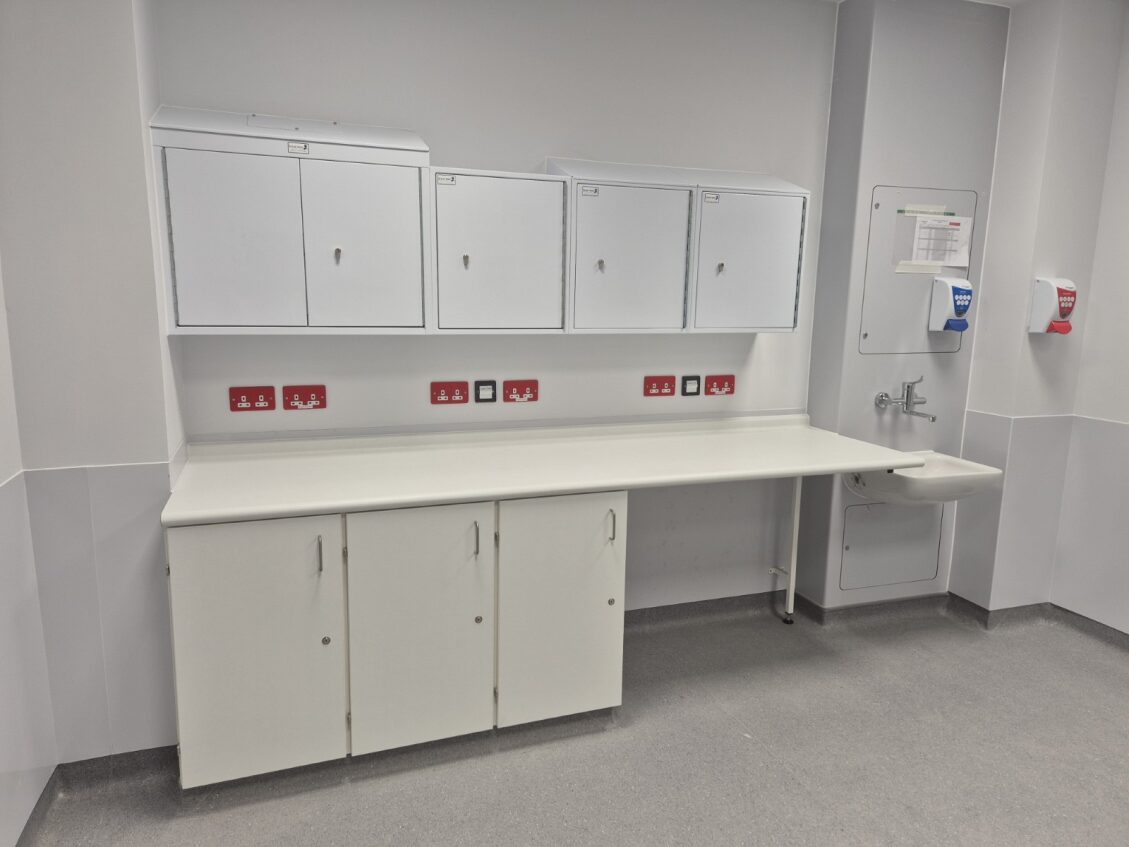Sustainability is no longer an aspiration - it’s a necessity. With the NHS Property Services…

Community healthcare and the role of fitted furniture in infection control
The NHS is transforming the way it delivers healthcare across the UK, with ambitious plans to establish a nationwide network of community health centres. The goal is to bring essential medical services closer to local communities, enhancing accessibility and reducing the burden on hospitals. These community health hubs will provide a range of primary care services under one roof, from general practitioner (GP) consultations to diagnostic testing and mental health support and much more, writes Tony Huggins, managing director, David Bailey Furniture Systems.
While this initiative is a positive step towards a more integrated healthcare system, one of the key challenges that needs to be addressed is infection control. Healthcare-associated infections (HCAIs) remain a significant concern in all medical settings, affecting approximately 300,000 patients annually in the UK. These infections are known to prolong hospital stays and require additional treatments, that can also have severe, life-threatening consequences.
This means, that as community health centres become an integral part of the NHS, ensuring that they adhere to the highest standards of hygiene and infection prevention is critical. One often-overlooked yet fundamental aspect of this strategy is the role of fitted furniture in infection control. Poorly designed or inadequately maintained furniture can act as a reservoir for bacteria, creating an environment where infections can be easily spread.
As a leading supplier of fitted furniture to the NHS for more than 40 years, we understand the importance of integrating infection-resistant materials and designs into healthcare environments. Fitted furniture always needs to be specifically designed to enhance hygiene, prevent bacterial growth and support NHS infection control protocols and this equally applies to community health centres.
The NHS’s vision for such centres aligns with a broader strategy to modernise the healthcare system and improve patient outcomes. By centralising various medical services within a single facility, these centres aim to provide more efficient and convenient care. Patients who previously had to visit multiple locations for different treatments will now have access to a wide range of services within their local communities, reducing travel times and improving healthcare equity.
The need for such centres has never been more important. Overcrowded hospitals, increasing patient numbers and long waiting times have put immense pressure on the NHS. Community health hubs serve as an essential solution by redirecting non-urgent cases away from hospital emergency departments, freeing up critical resources for those in need of immediate, acute care.
Several community health centres have already been established across the UK, serving as prototypes for the national initiative.
Camberwell Green Community Health Centre, London
Opened in 2021, the Camberwell Green Community Health Centre is a flagship example of modern, patient-focused healthcare design. This state-of-the-art facility provides a range of essential medical services including GP consultations, community nursing and minor surgical procedures. Designed with infection control and patient comfort in mind, the centre has set a benchmark for cleanliness and efficiency. By offering comprehensive care in a community setting, it reduces the strain on larger hospitals while ensuring that patients receive timely medical attention closer to home.
Birmingham Health and Wellbeing Centre
Launched in 2022, the Birmingham Health and Wellbeing Centre is a pioneering healthcare facility that integrates both physical and mental health services under one roof. With a strong emphasis on holistic patient care, this centre bridges the gap between traditional healthcare and community-based support systems. By addressing mental health concerns alongside physical ailments, it has significantly reduced unnecessary hospital admissions, ensuring that patients receive the right care at the right time. The centre’s design prioritises infection control, accessibility and a welcoming atmosphere, making it a model for future community health initiatives.
Bradford Community Diagnostic Centre
Since early 2023, the Bradford Community Diagnostic Centre has been revolutionising access to medical diagnostics. Equipped with advanced imaging technology including MRI scanners and blood testing facilities, the centre provides crucial diagnostic services closer to patients’ homes. This facility plays a key role in early detection and prevention, reducing the burden on hospitals by offering faster, more convenient access to essential medical tests. By streamlining diagnostic services within a community setting, the centre ensures faster results, quicker treatment plans and improved patient outcomes.
With the government’s pledge of £1 billion in funding, hundreds more community health centres are expected to open by 2027. The focus is on establishing these centres in underserved and rural areas, where healthcare accessibility has been a longstanding challenge.
Key regions identified for new community health centres
These are some of the areas chosen for new centres, based on a combination of factors, including healthcare accessibility gaps, population needs and existing infrastructure challenges.
It includes the northern regions of Cumbria, Durham and Northumberland, which will see significant investment in new healthcare centres, specifically aimed at improving access to diagnostic and primary care services. These areas are characterised by large rural populations, where residents often face challenges in reaching hospitals and specialist services due to distance and transportation constraints.
Investment is needed because of the long travel distances to hospitals in these areas. The prevalence of respiratory illnesses, cardiovascular disease and diabetes in these regions is also above the national average, necessitating better local management of long-term conditions.
Furthermore, shortages in rural areas have led to longer waiting times and limited appointment availability, increasing the burden on emergency departments.
The new community hubs will house GP services, diagnostic facilities (e.g., blood tests, X-rays, and ultrasounds) and outpatient clinics, reducing the need for hospital visits. Integrated mental health support will be a key focus, ensuring patients can access psychological therapies and crisis intervention services locally. In addition, telemedicine facilities will allow remote consultations with specialists, reducing patient travel and improving overall access to care.
The impact of these new centres will be profound, allowing thousands of patients to receive timely care in their communities while reducing unnecessary hospital admissions.
Cornwall and Devon
The South West of England has long struggled with healthcare accessibility due to its remote coastal and rural geography. Cornwall and Devon, in particular, face challenges in ensuring healthcare services are within easy reach for all residents. The new community health centres planned for these counties aim to address these accessibility issues, bringing high-quality healthcare closer to those who need it most.
Cornwall and Devon have a higher-than-average proportion of older residents, many of whom require regular medical care, mobility support and chronic disease management. Many rural villages also lack frequent public transport links to hospitals, making travel for healthcare a major challenge. The influx of tourists during peak seasons further increases demand on emergency departments, stretching resources thin and leading to longer wait times for local residents.
Improved access to primary and urgent care services will ensure that minor health issues can be managed locally, reducing pressure on hospitals. Specialist outreach clinics will also be available, offering consultations in areas such as cardiology, dermatology and orthopaedics – eliminating the need for long-distance travel. Maternity and child health services will be strengthened, ensuring expectant mothers and young families in rural areas have easier access to healthcare.
By expanding community-based services in Cornwall and Devon, these new centres will ensure timely interventions, reduced travel times and better health outcomes for residents.
Nottinghamshire, Leicestershire and Cambridgeshire
The Midlands and East of England have also been earmarked for major healthcare investments, particularly in Nottinghamshire, Leicestershire and Cambridgeshire. These counties face a mix of urban and rural healthcare challenges, requiring a tailored approach to improve access and efficiency.
Cities like Nottingham, Leicester and Cambridge have large teaching hospitals, but these are frequently overwhelmed by high patient demand, leading to long waiting times. This means there are significant disparities in healthcare access between urban centres and rural communities within these counties. Some residents struggle to access specialist services without long waiting times. These regions are also experiencing rapid population growth, putting additional strain on existing healthcare services.
Integrated primary care and diagnostic services will allow patients to access blood tests, imaging and minor procedures in local community settings rather than in overcrowded hospitals. The centres will also emphasise early intervention and chronic disease management, helping to reduce hospital admissions for preventable conditions.
Given that Cambridge and Nottingham are home to major medical research hubs, these new centres will further act as testing grounds for innovative healthcare solutions and digital health technologies. In short, this investment will help balance healthcare demand across the region, ease hospital pressures and ensure both urban and rural populations have equitable access to care.
By targeting Northern England, the South West and the Midlands/East of England, the NHS’s plan for community health centres aims to bridge critical healthcare gaps, enhance accessibility and improve patient outcomes. These investments will not only modernise primary and diagnostic care, but will also play a crucial role in infection control, sustainability and digital healthcare advancements.
The role of infection control in community healthcare
As these community health centres become a staple of the UK healthcare system, maintaining the highest standards of infection control will be essential. Healthcare environments are inherently high-risk settings for the transmission of infections, with bacteria and viruses spreading easily through direct contact, airborne particles and contaminated surfaces.
Historically, infection control has focused on stringent cleaning protocols, the use of antimicrobial hand sanitisers and improved air filtration systems. However, one area that has often been overlooked is the role of fitted furniture in maintaining a sterile environment.
They are an integral part of infection control measures. Poorly designed fitted furniture, with hard-to-clean surfaces, joints and crevices, can harbour bacteria and facilitate the spread of pathogens.
How fitted furniture enhances infection control
Furniture made from non-porous materials significantly reduces the risk of bacterial accumulation. It is also important that fitted furniture is crafted from moisture-resistant, non-porous surfaces that do not absorb fluids, making them easy to clean and disinfect.
Bacteria and viruses often accumulate in the small gaps and crevices, making it essential to incorporate advanced manufacturing techniques that eliminate unnecessary seams, joints and cracks, reducing the potential for microbial growth.
At David Bailey Furniture, many of our products can be manufactured with specialised materials that include antimicrobial coatings, which actively inhibit the growth of bacteria, fungi and viruses. These coatings provide an added layer of protection between routine cleaning cycles, ensuring that surfaces remain as sterile as possible.
The NHS has established strict guidelines for infection control in healthcare settings, including requirements for furniture materials, durability and cleaning protocols. This means that all fitted furniture solutions have to be fully compliant with NHS infection control standards, making them an ideal choice for new community health centres.
In addition to the technical aspects of infection control, maintaining a clean and hygienic environment is essential for patient trust and confidence. Studies have shown that patients are more likely to feel safe and comfortable in environments that appear visibly clean and well-maintained.
In community health centres, where patients will be receiving treatment in close proximity to others, ensuring that surfaces are spotless and free from contamination is crucial. By investing in high-quality, bacteria-resistant fitted furniture, these centres can demonstrate their commitment to patient welfare, fostering a sense of trust and satisfaction among patients.
The future of healthcare design lies in the integration of sustainability with infection control and a commitment to environmentally friendly manufacturing processes, utilising sustainable materials without compromising on hygiene standards.
As the NHS continues to expand its network of community health centres, it is essential to consider how fitted furniture design can contribute to both sustainability and infection prevention. Innovations such as self-sanitising surfaces, modular furniture for easier cleaning and AI-driven smart hygiene systems are shaping the future of healthcare environments.
The NHS’s community health centre initiative represents a transformative shift in UK healthcare, bringing essential services closer to patients and easing the burden on hospitals. However, as these centres take shape, their success will hinge on maintaining the highest standards of hygiene and infection control.
Fitted furniture will continue to play a vital role in this effort and at David Bailey Furniture, we are proud to support the NHS’s mission with our innovative, infection-resistant furniture solutions. By combining advanced design with practical functionality, we will help create healthcare environments that are not only clean and safe, but also welcoming and efficient.
About the author
Tony Huggins is managing director of David Bailey Furniture Systems, the country’s fastest growing manufacturer of specialist fitted furniture products for the healthcare sector, schools, medical and veterinary centres.
Tony, who joined Broadstairs, Kent, based David Bailey Furniture in September 2021 as Operations Manager is now charged with delivering plans to streamline the business still further following a major investment programme which has seen the company significantly expand its production capacity.
David Bailey Furniture has been established for more than 40 years and employs 38 staff. Their Healthcare range of fitted furniture features within some of the country’s largest and most prestigious NHS and private hospitals. It is also regularly specified for other healthcare furniture projects from health centres and nursing homes to doctors’ surgeries and dental practices.
In more recent years the company has also significantly increased its presence in the schools and veterinary markets and is now a major supplier to the prisons sector and other growing niche markets.








